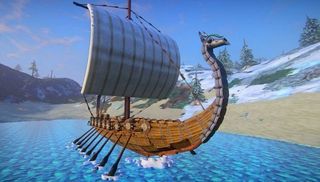Landmark hands-on: a malleable MMO with new adaptive AI technology

EverQuest Next was announced at the SOE Live convention in August last year. After the presentation, I approached people in the audience—longtime EverQuest players, most of them—and asked what they thought. Many were excited by the notion of a sequel, as you'd expect. A few didn't like the art. Most were still wrapping their heads around why SOE had chosen to build a block-building construction game alongside their new MMO, a game that even bore the EverQuest name.
Well, it doesn't any more. EverQuest Next Landmark is now simply Landmark, a change made to clarify that this isn't just a toolset for creating EverQuest-like environments. Landmark is a set of tools designed to enable people to create medieval cities, modern apartments, sci-fi landscapes, or whatever else they like—and then to populate those landscapes with adventures and AI that they can share with other people. Its connection to EverQuest Next is solely and simply that it's the same tool that SOE are using to build their next MMO—and while alpha testers help them develop those tools, they're applying that experience to EQN behind a curtain of secrecy.
Even with a bit of Minecraft and 3D modelling experience, getting to grips with Landmark is daunting at first. It's a paradigm shift in terms of tool complexity: not only can you place shapes other than cubes, you can resize those shapes, twist them, and use them to carve chunks out of one another.

Game director Dave Georgeson shows me how to create 'frames' that can be copied and pasted to manipulate other objects, exploiting a quirk of how voxel geometry is calculated to create even curves and complex details. It was a trick initially discovered by alpha testers, that the developers are now racing to include in their game in a more accessible form. I use it to build a giant PC Gamer logo, because I am boring.
These tools have a crucial role to play in shaping the next generation of MMOs. “One of the reasons we made the choices we have is we don't believe we can keep up with demand from players,” says producer Terry Michaels. “We've seen it from our own games as well as games from other companies—the constant challenge of trying to create content. We know that we can't create it as fast as players can consume it. It's just not possible.”
If you've played a fantasy MMO recently—or if you're currently playing The Elder Scrolls Online—you will have experienced this problem. The struggle to create enough stuff to do is why we end up with endgames stuffed with daily quests, repetitive raids, and so on.

“When we created the team for EQN we started with the concept of questioning how and why we do things,” says Michaels. “Just because this is how we've done things in the past, that's not how it has to be done.”
The biggest gaming news, reviews and hardware deals
Keep up to date with the most important stories and the best deals, as picked by the PC Gamer team.
At the moment, Landmark only has building tools. Combat and more detailed survival mechanics are coming next, followed by an AI system that players will also be given the power to tinker with. It is being developed in conjunction with London-based game design consultancy Storybricks, whose modular and language-based approach to AI throws out the restrictive and heavily scripted approach that's been used by MMOs in the past.
In Landmark and EverQuest Next, NPCs will navigate the environment based on simple desires and an understanding of the world based on simple symbolic terms—a temple area might be 'sacred', for example, while a road might signify 'civilisation'.

“Everybody works together to create systems, not finished 'content',” says Storybricks' Stéphane Bura. “That means that everybody is part of an experience that will be realised when the player uses it. We are providing a vehicle for the player's creativity.”
In EverQuest Next, these systems will be put in place by the designers. With Landmark, the developers are giving players the tools to create MMOs of their own.
What's crucial about this is that it isn't blue-sky thinking. It's a smart response to an old problem, grounded in principles proven by Minecraft, Garry's Mod, DayZ and others—players are creative, and will take ideas further than developers ever can.

For the MMO hardcore, it promises a more interesting, responsive world to explore. “Before, when we made a dungeon encounter we tested all of the ways in which you could break it,” says Michaels. “Now, we test the systems and we accept that there are actions that we can't anticipate. We allow the game to play out the way it would.”
Does this mean an end to extensive raid-planning and looking up boss solutions on community wikis? Perhaps. “Some of our long-term players might not like this game, and we accept that because we think it's important to progress,” says Michaels. “We hope they like it, but we're not going to hinder the design by conforming to what we've done in the past.”
Joining in 2011, Chris made his start with PC Gamer turning beautiful trees into magazines, first as a writer and later as deputy editor. Once PCG's reluctant MMO champion , his discovery of Dota 2 in 2012 led him to much darker, stranger places. In 2015, Chris became the editor of PC Gamer Pro, overseeing our online coverage of competitive gaming and esports. He left in 2017, and can be now found making games and recording the Crate & Crowbar podcast.
Most Popular

